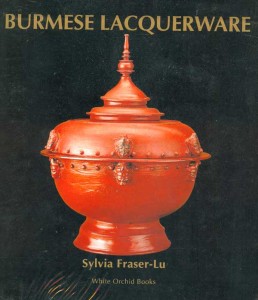(see also WoWasis’ Burma Fiction bookshelf)
The exoticism of Burma has been well-documented in fact and fiction. Well-known writers such as George Orwell have based their novels on Burmese political and cultural life, while a number of non-fiction writers have investigated Burmese topics ranging from the flora and fauna of the country to its complex and fascinating history. Travelers contemplating a visit to Burma will find their visits enhanced by reading about the nation beforehand, and investigating its political history from WWII onward is de rigueur.
Due to the dearth of bookstores in Burma, readers are advised to buy and read their books before traveling. While historical novels such as Orwell’s Burmese Days can be found in-country, they will generally be locally-made photocopies.
Warning: the carrying of any books or literature perceived to be critical of the present political régime may be grounds for expulsion from the country, and/or result in an uncomfortable interview with the authorities.
Non-Fiction books on Burma
It’s easy to be impressed by the richness of Burma’s arts and crafts traditions, and two books in particular stand out from both a scholarly and design perspective. Any visitor contemplating buying old lacquerware could do worse than read both, as they provide keen examples of the best.
Lacquer expert Sylvia Fraser-Lu has been writing on the subject for two decades, and her Burmese Lacquerware (2000, ISBN 974-8304-82-5) has wonderful photos, a fine explanation as to how lacquerware is made, and tips on where to buy. Her discussion of Bagan lacquerware shops is of particular interest.
Ralph Isaacs and T. Richard Blurton have written Visions from the Golden Land: Burma and the Art of Lacquer (2000, ISBN 1-878529-69-2), another wonderful book on lacquerware, with some particularly fine examples of hsun-ok (bowls to carry food alms to monks.
The Golden Triangle area of Burma, Thailand, and Laos is incredibly rich in Tribal culture, jewelry, crafts, and clothing. Paul and Elaine Lewis’ Peoples of the Golden Triangle (1984, ISBN 974-8225-42-9) is a wonderfully written and photographed book, and photographically one of the most compelling we’ve yet seen.
Richard K. Diran’s large-format photo essay, The Vanishing Tribes of Burma (1997, ISBN 1-84188-032-9) has exceptionally beautiful photos of people from thirty-one of Burma’s tribal groups.
Burmese marionette puppets can be seen throughout the country, in shows and shops. Author Ma Thanegi has written an extremely informative book, The Illusion of Life (1994, ISBN 974-8299-61-9) on the history and culture of these figures. Thanegi describes the different characters, their construction, history, and profiles of famous Burmese puppeteers.
Pamela Gutman provides a nice history of Burma’s old realms along the Bay of Bengal in Burma’s Lost Kingdoms: Splendours of Arakan (2001, ISBN 974-8304-98-1). Included is a map of Myauk U, accompanied by Zaw Min Yu’s splendid photographs.
Alan Rabinowitz’ struggle to establish a successful wildlife sanctuary in Burma is richly detailed in a fascinating first-person narrative Beyond the Last Village: a Journey of Discovery in Asia’s Forbidden Wilderness (2001, ISBN 1-55963-799-4). The book amalgamates adventure, conservation theory, and political process, and is essential reading for anyone interested in flora and fauna conservation in developing nations.
To a large extent, the study of Burmese politics is a study of its military. Timothy Syrota’s sardonic Welcome to Burma (and Enjoy the Totalitarian Experience) (2001. ISBN 974-524-00807) discusses the relationship between the Burmese military and its citizens, and offers insights into day-to-day life in today’s Burma. We found his explanation of the relationship between the Burmese Army, the Shan State Army, and the United Wa State Army to be informative.
For a more scholarly approach to Burma’s recent military history, Christina Fink’s Living Silence: Burma Under Military Rule (2001, ISBN 974-7534-68-1) is highly recommended.
Nearly 60 years after George Orwell’s Burma adventures, writer Emma Larkin retraced his steps in Secret Histories: Finding George Orwell in a Burmese Teashop (2004, ISBN 0-7195-5699-6). This will be of interest mostly to Orwell enthusiasts, as Larkin’s observations on the modern Burmese social and political situation have been better covered in other books.
Mike Tucker is an author who patrolled with the Karen National Liberation Army. His The Long Patrol: with Karen Guerillas in Burma (2003, ISBN 974-8303-79-9) offers an insider’s view of the political perspectives of, and military skirmishes between the guerillas and the Burmese Army.
Inge Sargent, an Austrian who now lives in the U.S., was a Shan princess who, as Thusandi, Mahadevi of Hsipaw, was married to Sao Kya Seng, Prince of Hsipaw. In Twilight Over Burma: My Life as a Shan Princess (1994, ISBN 974-7100-61-4) she details her life in Burma, the death of her husband, and her flight under duress. Although the book meanders, it serves as a good introduction to the Shan way of life, as seen by Hsipaw’s last ruling family.

[…] large numbers of travelers now visiting the country of Myanmar. Sylvia Fraser-Lu’s landmark book Burmese Lacquerware is in its second edition, but ordering it internationally is financially problematic, going for […]